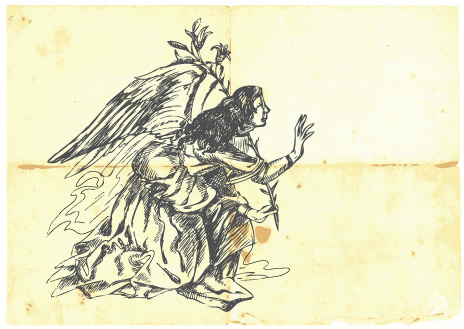
Γαβριήλ,
"man of God"):
By: Solomon Schechter, Ludwig Blau, Emil G. Hirsch
With Michael, Gabriel is mentioned by name in the Book of Daniel, where he explains to Daniel his visions (Dan. viii. 16-26, ix. 21-27).
He appears to Zacharias, and announces to Mary that she is about to have a son whose name shall be "Jesus" (Luke i. 19-31). Gabriel is one of the four angels that stand at the four sides of God's throne and serve as guardian angels of the four parts of the globe (Enoch, ix. 1; comp. Kautzsch, "Die Apokryphen und Pseudepigraphen des Alten Testaments," ii. 240, note).
The four angels, Michael, Gabriel, Uriel, and Raphael, who are still invoked in the evening prayer, are often mentioned together (Enoch, xl. 6, liv. 6; Sibyllines, ii. 214 et seq.; "Legend of Zechariah," vi. 2-6, in Lüken, "Michael: Eine Darstellung und Vergleichung der Jüdischen und Morgenländisch-Christlichen Tradition vom Erzengel Michael," p. 122, Göttingen, 1898).
The four names also occur on a golden tablet found in the tomb of the wife of Emperor Honorius (Kopp, "Palæographia Critica," iii., § 158; "Apocryphische Fragen des Bartholomeus," in Lüken, l.c. p. 114; "Zauberpapyri," in Lüken, l.c. p. 71). In other passages seven archangels are mentioned, among them Gabriel (Tobit xii. 15, and elsewhere).
But he is most often mentioned together with Michael, whom he follows in rank. A Gnostic gem bears the inscription in Greek: "Michael thehighest, Gabriel the mightiest" (Kopp, l.c. iv., §, 766).
The three angels that appeared to Abraham (Gen. xviii.) were Michael, Gabriel, and Raphael; Michael, as the greatest, walked in the middle, with Gabriel to his right and Raphael to his left (Yoma 37a). Michael stands at the right hand of God, Gabriel at His left (Jellinek, "B. H." v. 166).
Throughout Jewish literature Michael appears as an angel of a higher degree, as may be seen in the passages quoted below. Gabriel has the form of a man (Dan. viii. 15, ix. 21), and is, according to the Talmud, the "man clothed with linen" mentioned in Ezek. ix. 3 and x. 2 (Yoma 77a).






